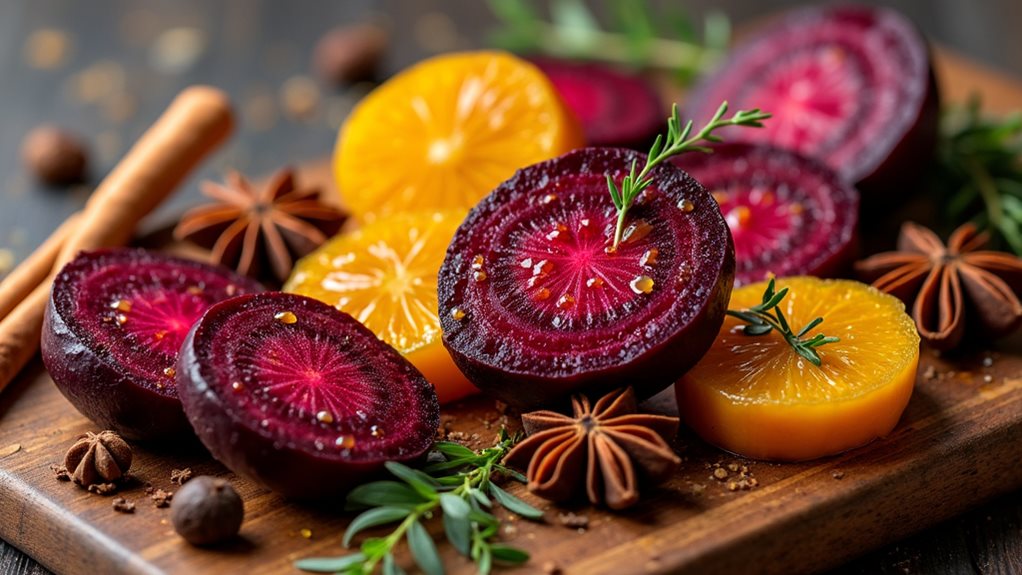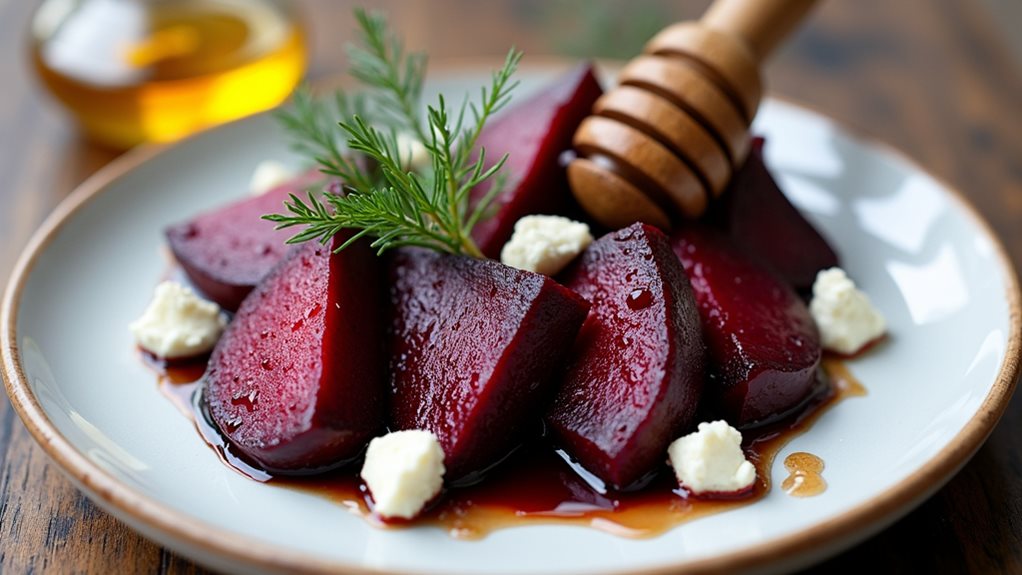Beets pair wonderfully with warming spices like ginger, cinnamon, and cardamom that enhance their earthy flavor. Try combining them with fresh herbs such as mint, basil, or thyme for brightness. You'll find citrus fruits, especially oranges, balance beets' sweetness perfectly, while nuts and seeds add essential texture. For dressings, consider balsamic vinegar or olive oil with a touch of honey. Explore these combinations to transform this humble root vegetable into stunning culinary creations.
Warming Spices: The Perfect Companion for Earthy Beets

When exploring the world of beet pairings, warming spices emerge as exceptional companions that transform these earthy root vegetables into culinary masterpieces. Ginger, cinnamon, and allspice cut through beets' geosmin-rich earthiness while adding aromatic depth that elevates both sweet and savory preparations.
You'll find cardamom particularly versatile, creating unique warmth whether you're making a vibrant salad or hearty roasted dish. A particularly delightful combination is pairing beets with cranberries and cardamom for a flavorful side dish that balances earthiness with bright fruit notes. Clove contributes a powerful, spicy note that, when used judiciously, complements beets beautifully.
The human nose is incredibly sensitive to the geosmin molecule, capable of detecting it at concentrations as low as 5 parts per trillion in beetroots. Remember that balancing these earthy spices with acidic elements like citrus or vinegar prevents the dish from becoming overwhelming. For innovative combinations, try layering multiple warming spices—perhaps a cinnamon-ginger blend—to create complex flavor profiles that showcase beets' natural sweetness.
Fresh Herbs That Elevate Beet Dishes
Fresh herbs can transform your beet dishes from ordinary to extraordinary, with Mediterranean options like mint and basil offering bright counterpoints to beets' earthiness.
Woody herbs such as thyme and rosemary stand in beautiful contrast to beets' sweetness, especially when you're roasting or baking them with butter.
You'll find that peppery herbs like oregano and parsley cut through the density of beet dishes, adding complexity and freshness whether you're creating a salad, hummus, or warm side dish. For a classic French touch, try seasoning your beets with herbes de Provence as suggested in the original recipe for perfectly roasted results. Adding fresh basil from your own garden provides a profound sense of accomplishment and emotional connection to your homegrown produce.
Minty Mediterranean Pairings
Though often overlooked in everyday cooking, mint serves as the perfect companion to earthy beets, creating a harmonious balance that's characteristic of Mediterranean cuisine.
You'll find that minty beet salads transform humble root vegetables into vibrant culinary experiences, especially when paired with citrus elements like orange or lemon zest.
Try creating invigorating vinaigrettes by combining fresh mint with lemon juice and olive oil—this simple preparation elevates the natural sweetness of beets while adding a cooling contrast.
For additional complexity, incorporate complementary herbs such as dill or basil, or experiment with warming spices like cumin or cinnamon.
Whether you're preparing Greek beet hummus or a Moroccan-inspired salad, mint's bright flavor cuts through the earthiness, resulting in dishes that are simultaneously grounded and uplifting. Consider soaking thinly sliced onions in cold water before adding them to your beet salad to reduce their pungency while maintaining their crisp texture.
The vibrant red color of beets indicates their high nutrient density, making them not just a flavorful addition but also a nutritious component of any Mediterranean dish.
Woody Herbs Contrast
Woody herbs create magical transformations when paired with beets, elevating these humble root vegetables into sophisticated culinary experiences. Your herb selection makes all the difference—thyme enhances earthiness with minty undertones, especially when paired with lemon, while rosemary's piney character complements roasted preparations beautifully.
For remarkable flavor synergy, try sage with caramelized onions to balance beet sweetness, or oregano with capers for Mediterranean-inspired dishes. Most woody herbs thrive in well-drained soil and require minimal maintenance when growing at home.
Don't overlook practical garden benefits; these herbs naturally repel pests from your beet plants. Sage in particular is excellent for deterring rabbits from your beet garden while simultaneously providing flavor benefits.
In salads, combine thyme-infused balsamic glazed beets with apples for invigorating contrast, or mix roasted beets with sage and goat cheese for a summer staple.
These woody herbs don't just accompany beets—they transform them, creating depth and complexity you'll appreciate with every bite.
Peppery Herb Applications
Peppery herbs introduce a dynamic dimension to beet dishes, contrasting with the more steadfast nature of their woody counterparts.
When creating peppery herb blends for beets, consider combining basil, cilantro, and mint to achieve a balanced profile that enhances the root's natural sweetness while cutting through its earthiness.
You'll find that layering these herbs toward the end of cooking preserves their volatile oils and fragrance.
For maximum impact, pair your herb flavor profiles with complementary elements—balsamic vinegar heightens sweetness, while citrus adds brightness.
Try incorporating arugula into raw beet salads for an additional peppery kick, or scatter freshly chopped parsley over roasted beets dressed with olive oil and lemon.
For a concentrated flavor experience, use a mortar and pestle to crush your herbs, which releases their essential oils more effectively than chopping.
These applications not only enhance flavor but also introduce textural contrast to your beet preparations.
A traditional combination of parsley, cilantro, and mint creates a refreshing counterpoint to the earthy sweetness of beetroot in salads.
Fresh basil particularly stands out with beets as it contributes a slightly peppery flavor that complements the vegetable's natural sweetness.
Vegetable Pairings for Colorful Beet Combinations
Pairing beets with complementary vegetables creates stunning rainbow medleys that'll captivate both your eyes and taste buds.
You can combine arugula's peppery notes or spinach's mild earthiness with beets to create a foundation of contrasting flavors that highlight each vegetable's unique characteristics.
For exciting textural variation, consider adding crisp bell peppers, sweet carrots, or revitalizing celery, which provide satisfying crunch against the tender, yielding texture of cooked beets.
Vibrant Rainbow Medleys
The visual symphony of a well-composed rainbow vegetable medley can transform an ordinary beet dish into an extraordinary culinary experience.
You'll create striking vibrant color contrasts by combining ruby-red beets with orange carrots, yellow bell peppers, green spinach, and purple cauliflower. These seasonal vegetable blends not only please the eye but also deliver complementary flavors.
For maximum impact, arrange your vegetables by color gradient, or toss them together for a more rustic presentation.
Consider adding texture with crunchy nuts like walnuts or pistachios. When preparing your rainbow medley, start by roasting vegetables separately to preserve their individual colors, then combine just before serving.
A simple dressing of olive oil, red wine vinegar, and fresh herbs will enhance without overwhelming the natural flavors of your colorful creation.
For optimal caramelization and flavor development, roast your vegetables at 425F (220C) for 25-35 minutes, ensuring the pieces are cut uniformly.
Texture-Rich Root Companions
Root vegetables create harmonious partnerships with beets, offering diverse textures and complementary flavors that elevate any dish beyond the ordinary.
When you're seeking colorful contrasts, pair vibrant beets with orange carrots and creamy white parsnips for a visually stunning plate that promises equally dynamic taste experiences.
Your texture exploration doesn't need to stop there. Introduce sweet potatoes for velvety richness against beets' firm chew, or add turnips for their slightly peppery edge.
Celeriac contributes a subtle complexity that won't overwhelm beets' earthy sweetness. For maximum impact, try combining three or more root vegetables with different textures—perhaps roasted beets, pan-seared parsnips, and a celeriac puree—creating a dish where each bite offers something new to discover.
For enhanced caramelization and depth of flavor, consider roasting your vegetable medley at 425F temperature during the final minutes of cooking.
Citrus and Fruit Pairings to Balance Beet Sweetness

Bright, tangy citrus fruits create the perfect counterpoint to beets' natural sweetness, offering a balanced flavor profile that elevates this humble root vegetable to culinary stardom.
Experiment with various citrus varieties, from the subtle sweetness of oranges to the bittersweet complexity of grapefruit, each bringing unique dimensions to your beet dishes.
Discover citrus magic—oranges bring gentle sweetness, while grapefruit adds sophisticated complexity to transform ordinary beets into culinary treasures.
Play with fruit textures by incorporating crisp apple slices, juicy pomegranate seeds, or tender orange segments that provide contrast to beets' earthy softness.
You'll find the acidity of lemon zest or a squeeze of citrus juice cuts through beets' richness beautifully.
For maximum impact, try roasting beets with a citrus glaze or tossing them in a fruit-based vinaigrette that amplifies their natural flavors while tempering their sweetness.
When combining beets with fruits in salads, consider adding aged balsamic vinegar to enhance the marriage of sweet and tangy flavors while providing depth to the overall dish.
Nuts and Seeds: Adding Texture to Beet Creations
While citrus brightens beets with acidity, adding nuts and seeds transforms these ruby gems into textural masterpieces that delight the palate.
You'll find that the perfect nut texture creates delightful contrast against beets' tender flesh, while seed crunch introduces dimension to even the simplest preparations.
- Toast walnuts or pecans before adding to roasted beet salads for enhanced nuttiness and depth
- Blend cashews with beets for luxuriously smooth dips that maintain nutritional integrity
- Sprinkle toasted pumpkin seeds over warm beet dishes for immediate textural excitement
- Incorporate pine nuts into beet pesto for a Mediterranean-inspired spread that elevates toast
The protein and healthy fats in nuts and seeds don't just improve texture—they transform beet dishes from simple sides into substantial, nutritionally complete offerings worth featuring at your table.
Using the same uniform sizes approach as with roasting vegetables, ensure your nuts and seeds are chopped consistently for balanced distribution throughout your beet creations.
Oils and Dressings That Enhance Beet Flavors

The perfect dressing can transform a humble beet from an earthy root vegetable into a culinary masterpiece worth savoring. Your oil selections make a significant difference—olive oil provides a robust Mediterranean base, while neutral grapeseed oil lets the beet's natural flavor shine. For Asian-inspired dishes, try sesame oil's nutty notes.
Create vibrant dressing variations by combining these oils with complementary vinegars. Balsamic vinegar adds sweetness that balances beets' earthiness, while apple cider vinegar contributes a revitalizing tang.
For creamier options, incorporate tahini or yogurt with a touch of honey to offset acidity. Don't forget aromatic additions like garlic, cumin, or lemon zest to elevate your creation.
These thoughtful combinations will amplify beets' natural sweetness while adding complexity to your dish.
Sweet and Savory Beet Dessert Combinations
Beyond enhancing beets with oils and dressings, you'll find these ruby gems shine remarkably in the dessert world where they bridge sweet and savory flavor profiles.
The natural earthiness of beets creates surprising harmony with both sweet and savory elements, offering innovative dessert possibilities you won't want to miss.
- Rich beet chocolate cakes and cupcakes gain exceptional moisture and depth from roasted beets, particularly when paired with cream cheese frosting for savory contrast.
- Create vibrant fruity beet smoothies by blending beets with bananas, strawberries, or blueberries for nutritious treats with antioxidant benefits.
- Incorporate spices like cinnamon, ginger, and nutmeg to enhance beets' natural sweetness in baked goods.
- Try unexpected combinations like beet cheesecake with orange zest or beet ice cream drizzled with balsamic glaze for sophisticated flavor profiles.
Consider pairing beets with fresh thyme for a delightful dessert that combines thyme's antioxidant properties with the earthy sweetness of beets.
Global Cuisine Inspirations for Beet Recipes
Exploring diverse global cuisines offers countless inspiring ways to prepare and enjoy beets. From Mediterranean traditions to Asian innovations, you'll discover Global Beet Variations that transform this humble root vegetable into sophisticated dishes.
Try Middle Eastern approaches by blending roasted beets with yogurt and dill for a vibrant dip, or embrace French elegance by combining beet greens with goat cheese.
Master Japanese Beet Cooking Techniques by glazing them with teriyaki sauce, or immerse yourself in South American flavors with Peruvian beet ceviche featuring citrus and aji amarillo peppers.
For something hearty, incorporate beets into an Ethiopian stew seasoned with berbere spice or a Moroccan tagine with warm spices and dried fruits.
Each regional approach reveals new dimensions of beet's earthy sweetness while introducing exciting textural and flavor contrasts.
Unexpected Flavor Matches That Make Beets Shine
While global cuisines offer traditional approaches to beet preparation, surprising and unconventional flavor pairings can transform this humble root vegetable into something extraordinary.
You'll discover that beets have an amazing ability to complement unexpected spice blends and unique fruit pairings that challenge traditional flavor profiles.
- Sweet meets earthy – Dark chocolate and beets create luxurious desserts where the earthy depth enhances cocoa's richness
- Tropical fusion – Dragon fruit's subtle sweetness provides a striking visual and flavor contrast to beets' intensity
- Spirit companions – Vodka and beets share Russian culinary history, making them natural partners in sophisticated cocktails
- Citrus surprise – Tangerine's bright acidity cuts through beets' earthiness while amplifying their natural sweetness
Consider creating a refreshing summer salad that pairs roasted beets with sweet watermelon cubes and crumbled feta for a perfect balance of sweet and salty flavors.
Frequently Asked Questions
Can You Eat Beet Greens, and How Do They Taste?
Yes, you can eat beet greens! They're packed with nutritional benefits and taste mildly earthy with a sweet undertone. You'll enjoy their tender leaves and slightly crunchy stems when sautéed, steamed, or added to salads.
How Do You Reduce the "Earthy" Taste Some People Dislike?
You'll reduce beetroot's earthiness through smart preparation: peeling after brief cooking, roasting to caramelize, adding acidic ingredients like lemon, and enhancing flavor with salt, herbs and contrasting ingredients like carrots or mint.
Which Cheeses Pair Best With Beets?
Looking for the perfect match? You'll find goat cheese, feta, Camembert, Brie, and ricotta are your best cheese varieties. These pairing suggestions balance beets' earthiness with creamy, tangy, or buttery contrasts you'll love.
Are Golden Beets Different in Flavor From Red Beets?
Yes, golden beets offer a milder, sweeter flavor profile than red beets, with less earthiness and more nutty notes. You'll notice this difference regardless of cooking methods—roasting, steaming, or raw preparations.
How Can I Prevent Beets From Staining My Hands?
You'll prevent beet juice from staining your hands by wearing disposable gloves or applying olive oil as a barrier. Advanced staining techniques include peeling under running water or using a colander to catch escaping juice.
Final Thoughts
With these flavor companions in your culinary arsenal, you'll transform humble beets from earthy wallflowers into the stars of your kitchen. Whether you're roasting them with warming spices, pairing them with citrus, or exploring unexpected sweet applications, beets offer a canvas as rich as their ruby-red hue. Trust your palate, experiment boldly, and you'll discover that these root vegetables dance most beautifully when partnered with complementary flavors.















